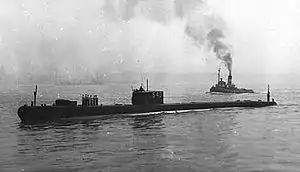HMS Excalibur
HMS Excalibur was the sister ship of HMS Explorer, the two submarines being the only high-test peroxide (HTP) powered submarines to be constructed for the Royal Navy. She is the only ship to be named as such, in honour of the sword of Arthurian legend.
 HMS Excalibur (S40) | |
| History | |
|---|---|
| Name: | HMS Excalibur |
| Ordered: | 26 August 1947 |
| Builder: | Vickers Armstrong[1] |
| Launched: | 25 February 1955 |
| Completed: | 22 February 1958 |
| Nickname(s): | The Excruciator[2] |
| Fate: | Scrapped 1968 |
| Notes: | Built at a cost of £1,142,000 |
| General characteristics | |
| Displacement: |
|
| Length: | 178 ft (54 m) |
| Beam: | 15 ft 8 in (4.78 m) |
| Draught: | 11 ft (3.4 m) |
| Propulsion: |
|
| Speed: | 25 knots (46.3 km/h) (submerged) |
| Complement: | 49 |
| Armament: | None |
Operation
Both Excalibur and Explorer were assigned to the 3rd Submarine Squadron although due to their experimental nature, they tended to operate independently, accompanied by their depot ship HMS Kingfisher and a fuel carrier, RFA Spabeck. They later acted as high speed underwater targets for the Royal Navy's prototype nuclear-powered submarine HMS Dreadnought.
Periscope

The submarine's periscope survives. It was installed in the starter's hut at the Golf House Club, the golf club at Elie and Earlsferry, Scotland; players and visitors may use it to view the golf course.[3]
References
- Oldships.org.uk HMS Excalibur
- Submarine Heritage Centre
- Ronnie Leask (12 October 2008). "NO4800 : Periscope in starters hut Elie Golf Course". www.geograph.org. Retrieved 19 September 2011.
Publications
| Wikimedia Commons has media related to HMS Excalibur (S40). |
- Colledge, J. J.; Warlow, Ben (2006) [1969]. Ships of the Royal Navy: The Complete Record of all Fighting Ships of the Royal Navy (Rev. ed.). London: Chatham Publishing. ISBN 978-1-86176-281-8.